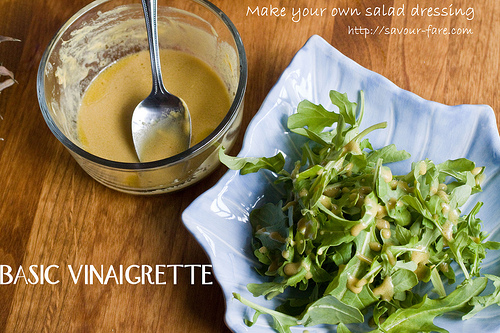
Despite what my husband thinks, I do try to avoid foodie preciousness. I’m short on time, like everyone else, and I make liberal use of shortcuts in my cooking. I get that premade ingredients make cooking easier and more accessible. But there are some things that making from scratch is such a deeply ingrained habit that I wouldn’t think of buying them premade. For example: I never buy bottled salad dressing.
Salad dressing may not seem like a hill to die on, but homemade is so simple (once you know how), and it tastes so much cleaner. It’s free of the gums and sugars and preservatives you get in even high-end bottled dressing. And it’s pretty infinitely variable.
Making salad dressing has become like breathing to me, but as I’ve been trying to put my feet up lately and assigning the salad making task to the husband, I realized that it’s not universal knowledge. The key is knowing what ingredients to use and what ratio to use them in.
I didn’t always grow up on homemade dressing. Sure, my mom always made Caesar from scratch, and my dad was a dab hand with blue cheese, but I remember a parade of bottles of Italian dressing marching through my childhood. Then balsamic vinegar came on the scene, and we started to dress salads with oil and vinegar. But it never had the feeling of “salad dressing.” I remember sitting at a little cafe in the South of France one summer when I was in high school, and wondering why my oil and vinegar dressing wasn’t like the perfect vinaigrette you find on every green salad in France.
And then I discovered the secret.
I discovered it in a little cookbook I bought at my college bookstore called Simca’s Cuisine. Written by Julia Child’s co-author in Mastering the Art of French Cooking, it was full of lovely little recipes. Including one for the basic French vinaigrette. Here it is. Are you ready? Red wine vinegar. Dijon mustard. Olive oil.
The key is in technique and ratio. Mix 1 part dijon mustard (PLEASE use Dijon and not yellow mustard. Or English mustard. Or Brown mustard. I beg of you.) with 1 part red wine vinegar (I’ll get into other vinegars later, but red wine creates the most basic vinaigrette) until the mustard and vinegar are combined. The mustard helps emulsify the dressing. I don’t know how. Then mix in 3 parts olive oil. (That’s key. Salad dressing is not low fat. Use less of it, but don’t skimp on the ratios). Use immediately, or stir again before using. You may have to salt to taste — most commercial mustards have some salt in them, so you may not. Simple. Easy. I usually mix it in the bowl before tossing in the greens.
Of course, once you’ve got the basics down, you can vary it all over the place. Lemon juice will yield a dressing with lighter acidity and a pronounced lemon flavor. Balsamic vinegar will make it sweeter. I like adding 1/2 part honey or maple syrup to the vinegar mustard mixture before adding in the olive oil. You can use different types of oil, but it’s worth it to use Extra Virgin Olive oil — the flavor does make a difference here. Chopped shallots, fresh herbs or minced garlic are also nice additions. Crumbled blue cheese or feta? Sure. Feel free to play. But stick with the ratios: 1 part mustard, 1 part acid, 3 parts oil.
Trust me, you’ll find yourself turning to it again and again.

- 1 tsp. red wine vinegar
- 1 tsp. dijon mustard (I use Trader Joe's in house brand, which is very good and also creates a dressing that is adequately salty for my taste)
- 1 T. extra virgin olive oil
- In a large bowl, mix the vinegar and mustard until combined in a slurry. Add the olive oil and beat (usually with a fork) until emulsified. Add your salad ingredients, toss to coat, serve with some crusty bread and whatever else you're having for dinner.

